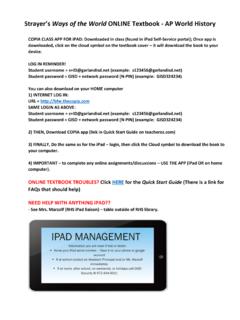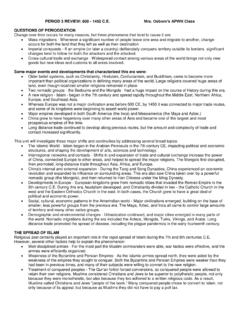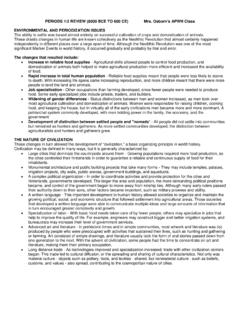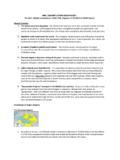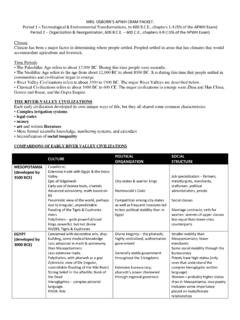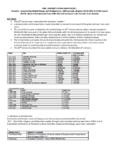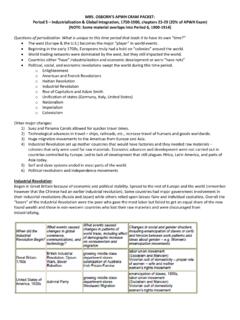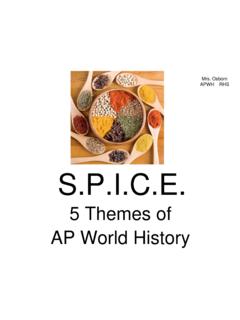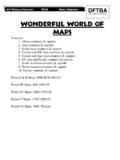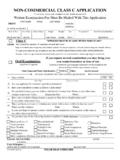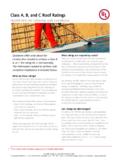Transcription of PERIOD 4 REVIEW: 1450 - 1750 C.E. Mrs. Osborn s …
1 PERIOD 4 review : 1450 - 1750 Mrs. Osborn s APWH class QUESTIONS OF PERIODIZATION This era includes only 300 years, but some profound and long-lasting changes occurred. Characteristics of the time between 1450 and 1750 include: 1) The globe was encompassed - For the first time, the western hemisphere came into continued contact with the eastern hemisphere. Technological innovations, strengthened political organization, and economic prosperity all contributed to this change that completely altered world trade patterns. 2) Sea-based trade rose in proportion to land-based trade - Technological advancements and willingness of political leaders to invest in it meant that sea-based trade became much more important. As a result, old land-based empires lost relative power to the new sea-based powers. 3) European kingdoms emerged that gained world power - The relative power and prosperity of Europe increased dramatically during this time in comparison to empires in the longer-established civilization areas.
2 However, Europe did not entirely eclipse powerful empires in Southwest Asia, Africa, and East Asia. 4) The relative power of nomadic groups declined - Nomads continued to play an important role in trade and cultural diffusion, and they continued to threaten the borders of the large land-based empires. However, their power dwindled as travel and trade by water became more important. 5) Labor systems were transformed - The acquisition of colonies in North and South America led to major changes in labor systems. After many Amerindians died from disease transmitted by contact with Europeans, a vigorous slave trade from Africa began and continued throughout most of the era. Slave labor became very important all over the Americas. Other labor systems, such as the mita and encomienda in South America, were adapted from previous native traditions by the Spanish and Portuguese.
3 6) "Gunpowder Empires" emerged in the Middle East and Asia - Empires in older civilization areas gained new strength from new technologies in weaponry. Basing their new power on "gunpowder," they still suffered from the old issues that had plagued land-based empires for centuries: defense of borders, communication within the empire, and maintenance of an army adequate to defend the large territory. By the end of the era, many were less powerful than the new sea-based kingdoms of Europe. MAJOR DEVELOPMENTS - 1450-1750 Changes in Trade, Technology, and Global Interactions - The Atlantic Ocean trade eventually led to the crossing of the Pacific Ocean. New maritime technologies made these interactions possible, and global trade patterns changed dramatically. Major Maritime and Gunpowder Empires - Major maritime powers include Portugal, Spain, France, and England, and major Gunpowder Empires were the Ottoman, Ming and Qing China, the Mughal, Russia, Tokugawa, Songhay (Songhai), and Benin.
4 Slave systems and slave trade - This was the big era for slave systems and slave trade, with the new European colonies in the Americas relying on slavery very heavily. The slave trade was an important link in the Atlantic Ocean trade. Demographic and environmental changes - The new trade patterns greatly altered habitats for plants and animals and resulted in changes in human diet and activities as well. Major migrations across the Atlantic Ocean also altered demographic patterns profoundly. Cultural and intellectual development - This era also was shaped by the European Renaissance, Protestant Reformation, and Enlightenment. Neo-Confucianism grew in influence in China, and new art forms developed in the Mughal Empire in India. CHANGES IN TRADE, TECHNOLOGY, AND GLOBAL INTERACTIONS The two areas that worked most actively to rebuild trade were China and Europe.
5 MING CHINA AND THE OUTSIDE WORLD When the Ming drove the Mongols out, they were intent on restoring the glory of Han China, and they turned first to restoring China's internal trade and political administration. Even though the Ming emperors were wary of foreigners, China had too long prospered from trade to give it up completely, and foreigners eagerly sought silk, porcelain and manufactured goods, in exchange for spices, cotton fabrics, gems, and pearls. In order to restore Chinese hegemony in Asia, Emperor Yongle sponsored seven naval expeditions commanded by Admiral Zheng He, whose voyages took place between 1405 and 1433. For each journey he launched a fleet of vessels like the world had never seen before. The Chinese junks were huge with nine masts, by far the largest ships ever launched up until that point in history. The main purposes of the voyage were twofold: to convince other civilizations that China had indeed regained their power and to reinstitute tribute from people that no longer gave it.
6 The latter did not bring any income to China, mainly because the cost of the voyages and gifts was more than any revenue they stimulated. Zheng He's voyages were halted in the 1430s when Emperor Yongle died. Confucian bureaucrats, who had little desire to increase China's interactions with other civilizations, gained control of the court and the new emperor, and refused to continue to finance the voyages. According to the new court, the money was needed to better protect the empire from its age-old problem: nomadic invasions from the west. The voyages and the Ming reaction to them provide good evidence for the pattern that was setting in: the impulse to trade and contact others v. the tendency to turn inward for fear of the negative effects on the Han Chinese. EUROPEAN EXPLORATIONS Across the globe, as the mid-15th century approached, kingdoms in another area were ready to venture to the open seas with motivations very different from those of the Chinese: Profit from commercial operations - Geographically, Europe was on the outskirts of the established trade routes.
7 The impractical nature of overland travel for Europeans was confirmed by the fact that the first European trade cities - Venice and Genoa - made their fortunes by sea travel. And so the Europeans set out to make their fortunes via water transportation. Spread of Christianity - True to its roots, Christianity had remained over the centuries a missionary religion. The Catholic Church took this responsibility seriously, and as a result, Europe was overwhelmingly Catholic by 1450. Once they began traveling to other lands, they aggressively promoted the spread of the Christian faith, so that their missionary motives were often as strong as their desire for profits. PORTUGUESE EXPLORATION Portugal was the first European kingdom to explore other lands seriously. For most of the 16th century, the Portuguese dominated the Indian Ocean trade.
8 How did they capture this old sea route that had been shared by Arabs, Persians, Indians, and Southeast Asians? The most important single answer is technological: they had superior weapons. Their ships were armed with cannons that they used so skillfully that their relatively small ships could overpower almost any other type of vessel. The Portuguese were intent on converting all that they met to Christianity, although they often did more harm than good, infuriating the natives by burning down mosques and/or forcing conversions. EARLY SPANISH EXPEDITIONS - THE CONQUEST OF THE AMERICAS What Diaz, da Gama, Columbus, and other early European explorers did do was unwittingly start an entirely new era of world trade and cross-cultural exchange. Europeans conquered and claimed the territories and greatly increased their prosperity and power, and Christianity spread to a whole new hemisphere.
9 Portugal and Spain even presumed to divide the world in two by seeking the Pope's blessing on the Treaty of Tordesillas, which drew a line through north and south through the Atlantic, giving Portugal the lands east and Spain the lands west. Portugal actually lost in the long run because the lands that they "received" were already claimed by empires that did not recognize the Portuguese claims. During the 16th century the Portuguese slowly faded as a power while Spain claimed and kept more and more land in the western hemisphere. In 1519 a Spanish expedition led by Hernan Cortes marched to the Aztec capital of Tenochtitlan and defeated the great empire with only a few hundred soldiers. How? Two weapons helped a great deal - guns and disease. Gunpowder technology revolutionized the world during the 1450-1750 era, and the Amerindian Empires were among its first victims.
10 Disease also made a big difference. Shortly after the Spanish arrived in Tenochtitlan, a smallpox epidemic broke out in the city that killed or incapacitated the Aztec army. A few years later Francisco Pizarro attacked and defeated the Inca. With the fall of those two empires the Spanish gained virtual control of Mesoamerica and South America, with the exception of Brazil, which fell on the Portuguese side of the line set by the Treaty of Tordesillas. THE FRENCH AND ENGLISH IN NORTH AMERICA The French and English did not arrive in the Americas until the 17th century, but when they did, they claimed much of North America in areas that the Spanish did not go. The French explored and settled the St. Lawrence River area through Canada, as well as the Mississippi River valley south all the way to its mouth in the Gulf of Mexico. The English settled along the eastern seacoast in North America.
